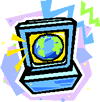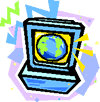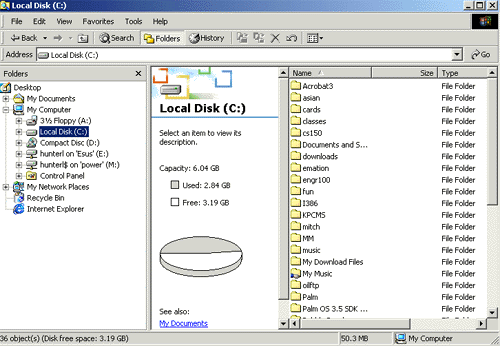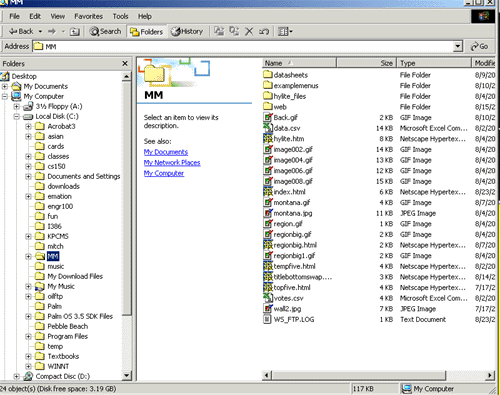 |
CS 150 Computer Literacy Folders |
 |
- Directory or folder
- Before Windows 95 the term directory was used to describe a collection of common files or other subdirectories. When Windows 95/98 was released, the term directory was changed to folder. So you should understand that the terms "Directory" and "Folder" are synonymous.
- Default folder
- the folder the computer will use unless you tell it to use a different one
- Current folder
- the folder you choose to work in at a particular time
- Root directory
- it's the beginning directory/folder. Everything else spreads out from the Root. There's more information on this term in the upcoming material
- Folder and subfolder
- a collection of common files or other folders
- Files
- a collection of data about a particular topic
- Hierarchical structure
- an organized series of folders and files on your computer disk
- Path
- a road map for you and the computer
- very beginning of the hierarchical structure
- created when you format a disk the first time
- index of all the folders and files on the disk
- automatically updated each time you add or delete folders or files
- always identified by the drive name, a colon, and a backslash
- examples: A:\ C:\
- Each drive has its own root
- Use paths to locate and then open files
- Describes the exact location of an object folder or file on the computer
- Helps you locate folders and files
- To specify a path
- Type the drive letter, a colon (:) and a backslash (\)
- Type the names of the folders and subfolders that contain the file
- A backslash (\) should precede each folder or subfolder name
- Type the file name. A backslash (\) should precede the filename
- Keeps your disk, hard or floppy, more organized
- Makes it easier to find files
- Categorizes your data files
- Easier to copy or move files
- Easier to delete old files
Why do I need this?
This lecture is designed to familiarize you with the hierarchical structure of folders and files on your computer. It's important that you understand this information so that you can find files easier and maintain your folders and files in a structured way. I've also included information on how to "find" files on your disks. We often hear students complain that they "lost" the file they were working on. This happens often in the computer labs. Most of the time though, they didn't "lose" a file; they just saved it to the wrong disk drive or to the wrong folder. In other words, where you thought you were wasn't where you really are!Terminology
Before we start, here's some terminology we'll be using:Root Directory
Examples:
| Root Directory of the Hard drive: | C:\ |
| Root with the first folder: | C:\MyFiles |
| Root with first and second folders: | C:\MyFiles\CS150 |
| Root with first, second, and third folders: | C:\MyFiles\CS150\Spring2000\ |
| Root with first, second, and third folder and a file: | C:\MyFiles\CS150\Spring2000\exam1.wpd |
Paths
A folder path is analogous to a road map the computer uses to get to various folders and files. It also helps you find files easier. Both you and the computer need to know in what direction you must go to get to where you want to be. Paths help both of you do that.
So using the table above, look at the last example and read backwards from the extreme right. You can see the "path" I or the computer would use to reach the file called exam1.wpd that I saved in the folder for the semester pertaining to the CS150 class in My Files that are all stored on the hard drive.
Paths aren't used just for finding folders and files on your personal computer or floppy disks. The next time you are surfing the World Wide Web and you land on a particular site, look at the Location text box. Right after the domain name (i.e., cs.montana.edu) notice all that other stuff that's listed. See a folder name separated by a slash - / - , with perhaps another folder name followed by a slash and then lastly a file name with an extension? Guess what; that's the PATH the computer networks used to get you where you are. (Hint: if you're viewing this on the Web, look at the location box now to see the path that the computer followed to get you to this page.)
Creating Folders
You'll learn in the labs how to create Folders. Quick reviewWhy should you create and use folders?
A folder can contain other folders which would be considered subfolders. Confused yet? Maybe this diagram will help.

The CS150 folder is the main folder. The three folders listed below the CS150 folder are subfolders of the main CS150 folder. Each of them can contain other folders or files, whichever I choose. Still confused? I hope not because I've run out of ways to explain this concept.
Tips on Organizing Folders and Files
- Create folders to group related files
- by application
- by subject
- Separate data files and application program files
- simplify backup process
- prevent inadvertent deletions
- Put as few files as possible in the Root folder
Windows Explorer
The best way to see a hierarchical structure of a disk is to use the Windows Explorer. To do that follow these simple steps:- Click on the Start button.
- Click on Programs
- Find the Windows Explorer application in the resultant menu. Click on it
- Up pops the Explorer window that shows you all the folders on the left side. Maybe that's why they call that side the "All Folders" area.
- On the right side of the window is the area called "Contents" window. That's where you'll see a list of all the subfolders and all the files in a particular folder.

- The left side is all the drives on your computer.
- The right side shows the contents of whatever is highlighted on the right. In this example this is all the folders on the C: drive (hard drive).
- If you wanted to see the contents of the MM folder that is on the right side you would just click on it. The + next to the C drive would expand and all the folders on the right side would show up under the C: drive on the left side and then the MM folder would be highlighted and on the right side would be contents of the MM folder. like in the next picture

Moving, Copying, Deleting Folders and Files
There will come a time when you want to clean house. You'll want or need to reorganize your folders and files or get rid of some of them if no other reason than you are running out of space on your hard drive.Moving and Copying - there is a difference!
If you move a file you'll only have one edition of that folder/file in the new location. It will no longer be in the old location.If you copy a file you'll have the original edition of that folder/file in the old location and a second edition of that folder/file in the new location.
I'll give you examples of why you would want to do each operation in lecture class.
Deleting Folders and Files
Sooner or later you'll want to delete some of your folders and files. For instance, at the end of this semester you should delete all the folders/files that you created and used during this class (unless you really enjoy them!).There's a big difference between deleting folders/files from your hard drive and deleting them from a floppy disk.
Deleting folders/files from the hard drive is actually a two step process:
Using My Computer or Windows Explorer you delete them from their original location. They are sent to the Recycle Bin. If you decide later that you really did need that folder/file you can retrieve it from the Recycle Bin at this point. They'll stay there and on your hard drive until you empty the Recycle Bin. To do that:
- Click on the Recycle Bin
- Click on File
- Click on Empty Recycle Bin
Deleting a folder/file from a floppy disk is a one-step process. Use My Computer or Windows Explorer to get to the folder/file, click on it to highlight and hit the Delete key on the keyboard. When you delete a folder/file from a floppy disk it is immediately erased from that disk and you can no longer retrieve it - ever!
Some people try to delete a file by opening the file in the appropriate application, delete the contents of file and then close the application and file. Guess what? That doesn't delete the file itself - only the contents. You'll still see the file name on your disk. Deleting the contents does not delete the file itself. Use the instructions above to completely delete a file from a disk.
Using Search
It's not a matter of "if", it's a matter of "when" you'll lose a file that you just know you have somewhere. Here's some info on why you should use the search panel and how to use it to your advantage.- Why
- it's a quick way to find a file or group of files
- it's faster than opening and examining each folder
- it's faster than scrolling through every file you have on your disk
- it's easy
- Tips on using Search
- Click on the Start button. In the right panel select Search.
- Choose what you want to search for
- put in the file name
- choose a path to look in
- Use wildcards to make your search easier
- Wildcards (on older systems)
- an asterisk - * - is a substitute for one or more characters
- a question mark - ? - is a substitute for only one character
| To find all the letters to Mom use the question mark to substitute for one character | |
| Instead of | Use this |
| Mom1.doc | Mom?.doc |
| Mom2.doc | *om |
| Mom3.doc | Mom |
| To find all your Word files use the asterisk to substitute for more than one character | |
| Instead of | Use this |
| Ltr2Mom.doc | *.doc |
| Bobby.doc | |
| AuntDeb.doc | |
- Once you've completed the Named text box, make sure you have the root directory selected, and only the root directory, listed in the "Look In" text box like this: Ccsi (C:). Doing so makes sure you search all the folders on your hard drive and not just one in particular. If you want to search your floppy disk then substitute A: for the Ccsi (C:) in the Look In text box.
- Click on Find Now. If you have any files that you described in the Named text box they will be displayed in a list.
- The list will show you the name of the file and the PATH you need to follow to get to the file.
- There are a few more tricks to using the Find application. Read the Help area in Find to see other ways to search for files.
Now, when you "lose" a file that you just know you saved to your disk you'll be able to find it and know what path to follow to get there. You'll know why it's important to make folders and store your files in separate folders.
This computing stuff is getting easier all the time!
Students that didn't make this lecture.
- Go into Windows Explorer and create a folder called "CS150" on your hard drive or floppy drive. Know how to do this and also figure out which reserve characters on the keyboard cannot be used in a name of a file or folder.
- Figure out how to add new things, such as a folder to your START->PROGRAMS menu. If you go to the START button, and then up to PROGRAMS, you should have a folder called ACCESSORIES with things like calculator and a paint program inside. So what you need to do is add another folder called ACC that will show up right above the ACCESSORIES folder when you go to PROGRAMS.
- Also know how to add or delete icons from your desktop. For instance put a icon on the desktop for your favorite program so you don't have to go to the START button every time.
- That is all.